Increasing your weekly running mileage from say 10 miles to 20 can itself present a series of challenges and potential pitfalls but stepping into the world of 60-100 running miles a week can be a whole new ball game.
Though we all probably know someone who can happily run as much as they want whenever they want without becoming injured, the risk of running injuries increases substantially once we enter the higher mileage & frequency end of the spectrum.
Studies show that in 60-70% of running related injuries, increasing running mileage too quickly is a key factor. Our friend, Brad Beer, Author of You Can Run Pain Free agrees with us about this one.
So, what is the secret to increasing weekly run mileage safely?
Want to find out how to run more miles without falling prey to injury? Let’s find out:

How Do I Know What Mileage My Body Can Handle?
When it comes to reducing the risk of running related injury, it is important to bear in mind that although passion & desire can get you a long way, your body does have its thresholds.
Most running injuries can be regarded as a sign that you have pushed your body beyond its thresholds.
It therefore makes sense that in order to reduce risk of injury you need to be aware and monitor the weekly load or in other words stress you are placing on your system, and ensure that you are by all means pushing yourself to your limits, but not exceeding them.
You may have noticed that in the previous sentence I used the word system instead of body.
This is deliberate in order to highlight the fact that when we talk about load and stress, we are not just referring to what your muscles, bones, tendons and ligaments have to deal with when running.
We are also referring to the stress from working too hard, sleeping too little, eating inappropriately, arguing with your partner, screaming at the kids; this stress plays just as important a part in determining how close you are to crossing your overall load threshold, and can often mean the difference between a niggle that disappears after pulling back a bit and a debilitating pain that lasts for weeks.
How long does it take my body to get used to running more miles?
The good news is, your thresholds are not permanent; they can be raised if an appropriate level of stress is applied.
One of the many amazing things about the human system is its ‘plasticity’.
When the system is placed under load or stress, it will adapt in an attempt to allow the body to get better at dealing with that specific load or stress in the future.
Bones provide a good example of this adaption.
The mechanical stress on bones caused by the impact of running stimulates bone growth, so they become thicker, harder and more able to deal with the same stress in future.
This is why running at a suitable volume and intensity has been shown to actually reduce risk of osteoarthritis (despite the ageless myth that running causes arthritis).
The same thing happens to muscles, tendons and ligaments when subjected to suitable stress via resistance training.
Why do I get injured when I try to run more miles?
If the stress or load placed on your system is above your threshold, the adaption that occurs in your body may not be beneficial.
Too much stress on the bones can cause the outer layer (periosteum) to become irritated and if you either ignore or don’t notice the ‘spreading out’ type of pain commonly experienced at this stage, the irritation can develop into a stress fracture (in which the pain becomes more localised, progressively worse and eventually causes you to have to stop running).
Bones, muscles, tendons & ligaments are not the only ‘plastic’ part of the system – the brain & nervous system is plastic too and thanks to modern day functional MRI scans can be seen to also adapt when stressed.
Your nervous system continuously receives sensory feedback that essentially allows the brain to perceive what’s going on in the outside world.
If the brain perceives a potentially dangerous situation, one method it can use to protect you is output pain.
This is why it is important to monitor & reduce as much as possible your overall stress in life, especially when it comes to social media sharing and feeling bad about yourself because of what others are sharing.
Here’s the deal:
Picture your system threshold as an empty glass – if it’s already filled up to half way with stress from your life, you only have the remaining half left to fill with ‘running’ stress before you exceed your threshold and suffer the consequences.
We talked about this in further detail on our article about ego depletion if you are curious, it may be why your running is suffering.
How Do I Reach the Higher Mileage Without Getting Injured?
With all of this in mind, let’s now look at ways to help you increase your mileage to beyond 60 miles a week without seeing your stress glass overfill.
Build your base miles first
Running load can be increased in three ways: run further (increase mileage), run harder (increase speed or incline), or run more often (increase frequency).
The first golden rule for avoiding overload especially in the early stages of building mileage is avoid any sudden increase in any of these factors
The second rule is avoid increasing two or more of these factors at the same time; in other words, if you’re going to be increasing your weekly mileage by running further, drop the speed & hill workouts during this transition and don’t suddenly start running everyday of the week if your system is only used 3 times a week.
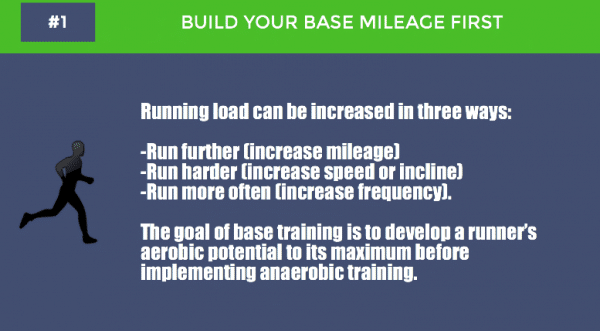
Keep a training plan
Though ‘running more miles’ may sound attractive in itself, it is always useful to have a tangible goal.
Left to our own devices, we are nearly always tempted into making sudden increases in volume, intensity or frequency, and as we stated above this more often than not can lead to injury.
Choose a race and form a training plan around it.
If it is a marathon training schedule you are after, we have a free 9 part guide on how to do just that. If you are building for a 5k or 10k, base training is slightly different.
This will allow you to focus more intelligently on increasing your mileage safely and productively, e.g. building foundational miles first and then adding more specific tempo runs.
Now:
Running two times in one day should only really become an option once you are running over 70 miles a week.
Though the temptation may be there to swap one long run with two shorter ones, it does mean you will be getting less recovery between runs
As always, write the plan in pencil.
Though as humans we tend to like the discipline offered by a structured formula (see the ‘the 10% rule’ below), we can never know for sure how our body will react to the planned sessions, just as we cannot plan ahead for storms, illness, extra hard days at work, etc.
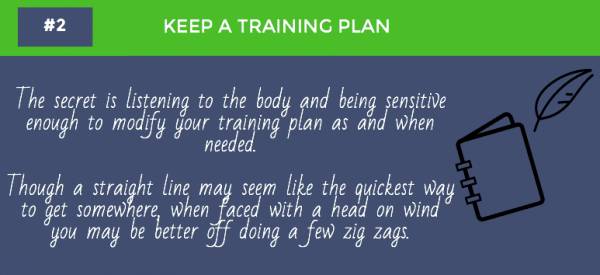
The 10% rule is not always best
One of the most commonly cited pieces of advice given for increasing miles safely is the ‘10% Rule.’
Though Its roots are unknown its simplicity is very attractive: as long as you increase your mileage by no more than 10% each week you should be fine. Though following such a system can in theory prevent sudden increases in volume, the rule does have its setbacks.
A 2014 study published in the Journal of Orthopaedic & Sports Physical Therapy that followed 873 new runners for a whole year showed that runners who had increased their mileage by more than 30% had a higher injury rate than those who had increased their mileage by less than 10%.
These injuries included patellofemoral pain (runners knee), Iliotibial band (IT band) syndrome, medial tibial stress syndrome, patellar tendinopathy, greater trochanteric bursitis, and injury to the gluteus medius or tensor fascia latae.
Check this out:
However, no correlation was seen between excessive mileage increase and plantar fasciitis, Achilles tendinopathy, calf injuries, hamstring injuries, tibial stress fractures or hip flexor strains.
The implications of this study are that these latter injuries may be related to other training errors.
The problem is, adaption of the body to stress is not always linear.
Research suggests that the body may adapt better during a period in which no extra stress is added (particularly in the case of bone stress).
This is the theory behind Olympic coach Jack Daniel’s ‘Equilibrium Method’ in which you increase your mileage gradually to a new level but then stay at that level for 3-4 weeks before increasing again.
Another popular method that many coaches today employ is having a ‘down’ week once a month in which you decrease your running mileage by 10-20%. This again helps ensure your body is getting adequate time to recover and adapt.
We compared the three training types in more depth in a previous article about increasing mileage.
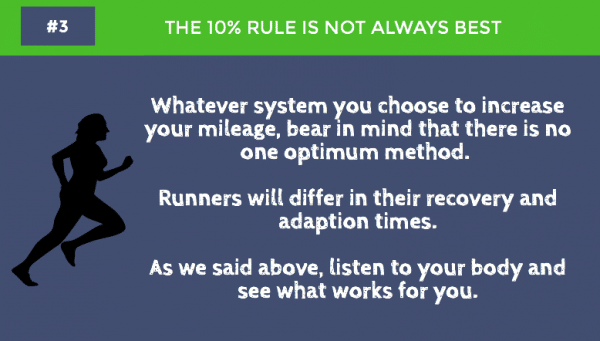
Prepare For lifestyle changes
We have already looked at the important role life stress plays in reducing risk of pain and injury.
Running can be a terrific way of leaving your worries behind you but in most cases they will still be there when you get back!
Finding the time to run 60+ miles a week will for most runners mean sacrificing time spent elsewhere.
That can mean less time with family, friends, work colleagues – people who may not quite understand why you have decided to opt for running instead of spending time with them.
Remember, stress is stress, whether it’s caused by increased tissue load or arguments at home because you’re going out running again.
As well as ensuring you have time to amicably add extra miles, be prepared for also needing more time to recover.
Modern research stresses the importance of quality sleep in reducing risk of injury, with some studies suggesting that anything less than 8 hours can be detrimental.
All too often, time to run is made at the expense of hours spent sleeping.
This is counterproductive.
By running more you are filling up the stress glass; by sleeping less you are filling up the stress glass even more; it’s a no win situation.
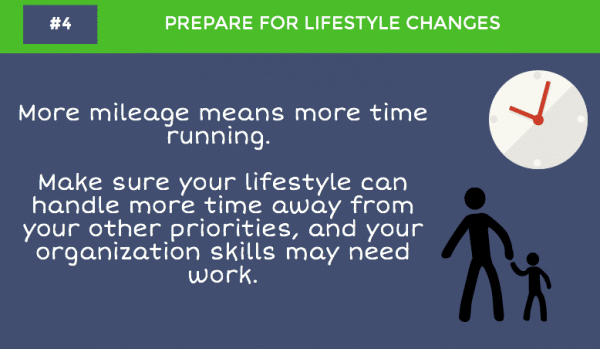
Do I need to change my diet?
Another area that can suffer when you start adding miles to your week is food intake, both quantity & quality.
In the busy age we live in of early starts, rushed lunch breaks and late finishes, many runners already find it tough to maintain fuel levels (and remember, we do not have a free pass to eat whatever we want because we run!).
If you are planning to add more running miles to your week, you will need to take a good look at your available eating times and food preparation.
Though the direct cause of many running related injuries is unknown, consuming too little calories to sustain the demand you are imposing on your body is bound to play a major part in dictating your susceptibility to injury.
During your run, you break down muscle; you then have a two hour opportunity immediately after the workout to replenish the body with the building blocks needed for repair, adaption and ultimately strength gain.
Intake of protein within this time period is particularly important for replenishment but research also shows that combining protein with carbohydrate can be even more beneficial (hence the rise in popularity of chocolate milk after a run), as carbohydrates are thought to stimulate protein synthesis as well as perform their traditional role of refilling depleted glycogen stores.
In other words, rather than just tucking into a chicken breast, consider sticking it in between some bread or having it with some rice or potato.
Calcium intake is something in particular that distance runners are advised to keep on top of in order to reduce risk of bone stress injuries, yes, that means stress fractures!
Studies suggest that many people fail to consume enough daily calcium. The recommended daily intake depends largely on age: for teens, 1,300mg is advised.
For adults over 17yrs it is 1,000mg a day.
For post-menopausal women over the age of 50 and anybody over 70, the figure rises to 1,200mg per day.
The most popular source of calcium intake is dairy products such as milk, yogurt, and cheese. Runners who have intolerances to dairy can seek other sources like kale, broccoli and small boned fish like sardines.
If you can get your recommended intake in food form then all the better; if for some good reason you cannot, there are various forms of calcium supplements on the market.
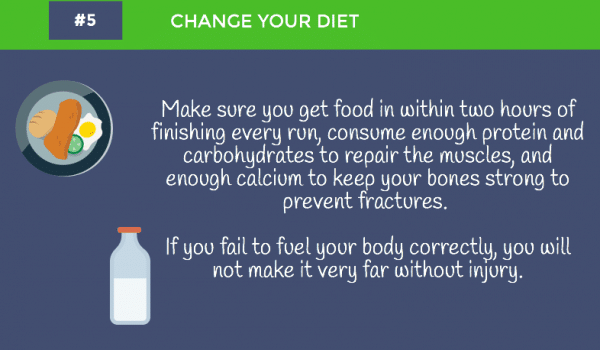
Does it matter what shoes I wear and where I run?
Many running related injuries can be associated with repetitive overload.
If you are adding more miles to your week, you are obviously increasing the chance of overload.
Varying the surface you run on (e.g. road vs off road) and maybe even the type of shoe you run in (slight changes in shoe structure can have a significant effect on which tissues in your body deal with what forces) can have a positive effect on reducing the risk of tissue overload.
Now:
There are however some important notes to take into consideration.
Firstly, any changes you make need to be introduced slowly and gradually, i.e. if you have never run on a trail before don’t suddenly go and do 10 miles.
Likewise, if you are experimenting with different types of trainer, make sure the differences are slight (e.g. don’t go from a traditional 10mm drop trainer to a zero drop minimalistic shoe), and make sure your first run in the new shoes is not too far.
Secondly, some runners will find through experience that their bodies are simply always going to be happier running on road as opposed to off road, or vice-versa.
Likewise, some runners (although in my experience this is less common) may discover that even if they introduce a new shoe gently, they only really perform well & niggle free in one certain shoe.
Remember as human beings we are all very different when it comes to physiological response to load. Different thresholds, history, structural anatomy, all of these mean we cannot expect to react in the same way as the runner next to us.
How do dynamic warm up and running drills improve performance?
Broadly speaking, runners are infamously poor at performing an adequate warm up.
Us? Dodging warm ups? Never!
We just want to get out there and run. Plus we all have friends who happily run sixty miles a week and never bother warming up.
As far as the research goes, we know that for most runners static stretching before a run (e.g. holding a hamstring or calf stretch for 20+ seconds) is unlikely to reduce risk of injury (Pope, 2000) and in some cases may even decrease performance (Wilson, 2010).
In contrast, dynamic mobility exercises (leg swings, knee raises, lunges, etc.) have been shown to potentially improve performance if the duration of the exercise is prolonged enough (Behm, 2011) with the study concluding “A warm-up should be composed of a sub-maximal intensity aerobic activity followed by dynamic stretching and then completed with sport-specific dynamic activities.”
Unlike ballet or martial arts, running does not require a great deal of flexibility.
Most people already have enough range of movement in their joints to run, and most injuries occur when muscles are lengthening within their normal range of motion.
What running does require is control and coordination; flexibility is not a skill but mobility – being able to coordinate movement throughout a specific range of movement as and when required – is a skill, and one that that needs practicing.
Why do runners need strength training to be 27% more efficient?
Adding some specific strength training to your week is for most runners one of the best pieces of advice we can give when deciding to increase mileage.
To understand why, consider running as a series of hops from one leg to the other, with the muscles and tendons acting like springs.
When you land, the muscles and tendons absorb and store energy from the ground and then use it to propel you forwards (referred to as the ‘stretch-shortening cycle’).
Imagine a spring with very little tension: on impact with the ground it will absorb and release very little energy.
Now imagine a spring that tense: it will store much more energy on impact and in doing so release more energy for each stride.
Though we think of ‘stiffness’ as a bad thing for runners, it is in fact a very important attribute that is most likely linked to both performance enhancement and injury prevention. Born to Run author, Christopher McDougall talked about this in further detail when we had him on our Run to the Top Podcast.
One study on elite runners has shown that those who were 20cm less flexible during a sit-and-reach test ran 27% more efficiently.
Strength work, particularly plyometric exercise, gives you tense, responsive, productive springs.
With regards to injury prevention, the conclusion of a 2013 systematic review (Lauersen 2013) of over 25 studies of exercise interventions designed to prevent sports injuries (26,610 participants and 3464 injuries) was as follows: “Strength training can reduce sports injuries to less than a third and overuse injuries by almost 50%.”
Though this study was not specifically for runners, most running related injuries are a product of overuse, and if you are planning to increase your weekly mileage you are obviously increasing use.
Interestingly enough, the same study also concluded that with regards to injury prevention there was “no beneficial effect for stretching.”
As far as what type of strength training to do, suffice to say – keep it simple & heavy.
As distance runners the perception is we need to lift a light weight many times, but remember we are preparing our body for that stretch-shortening cycle we mentioned earlier, that powerful spring from one foot to another.
To replicate the demands of running we need to lift heavy for less reps, with a resistance or weight that allows you to do no more than 12-15 repetitions (whilst maintaining good form).
So think squats, deadlifts and jumping exercises as opposed to 5 minute planks or 100 curl ups.
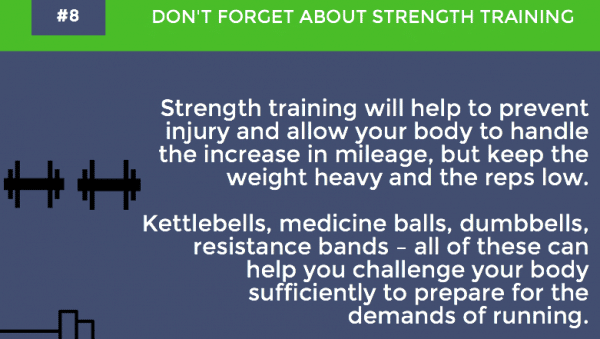
We hope this article has given you some ideas as to how to increase your mileage safely.
If you have recently managed to enter the 60+ miles a week club and would like to share any experiences, positive or negative, do please let us know!
Happy Running!
Matt Phillips is a Running Injury Specialist & Video Gait Analyst at StrideUK (http://www.strideuk.com/) & Studio57clinic (http://studio57clinic.co.uk/). Follow Matt on Twitter: @sportinjurymatt

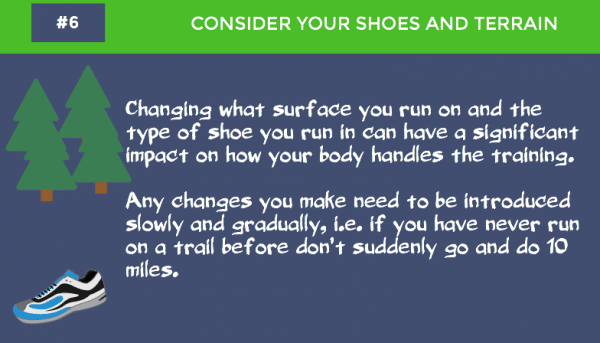
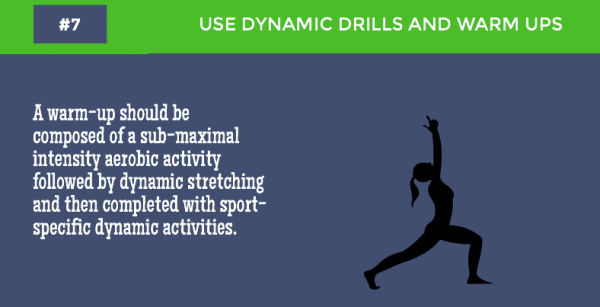







One Response
Great article. Lots of points to consider.
I recently was training for a 50km mountain trail race. I was upping the mileage from about a 40mpw base to 50/55/60 then a down week of 30…then 65/70/75. I made the mistake of running two 20 mile runs on my 75 mile week and half way through the second 20 mile run, i got a radiating pain down my lower leg starting at the knee (ITBS). Since then, I’ve taken a few weeks off and have been reading about hip/glute/posterior chain engagmement – i’ve come to realize that I’m completely weak in this area and have no leg strength other than that which has come from running.
I was 31min 10k runner in college running 90 miles a week – but never once did any work on leg strength in any form – just hard track workouts and “off days” that were too fast. At 42 years old, I’m realizing that these muscle groups have been completely neglected. Upping the miles for me isn’t really the issue – the issue is with the increased intensity and overuse, the muscles have ZERO extra strength to draw from.
The article about 5 myths of strength training was also very helpful. (https://runnersconnect.net/myths-about-strength-training-for-distance-runners/).
Thanks
Dave